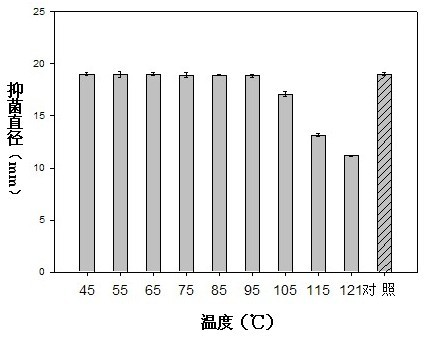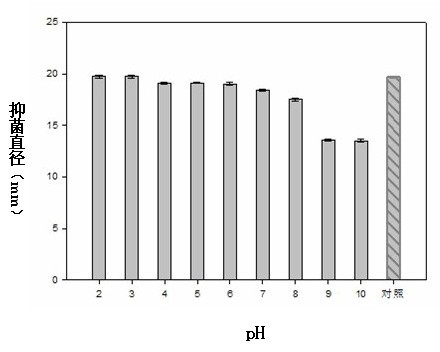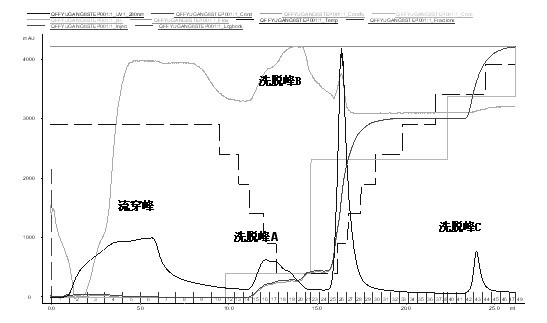Application of bacillus subtilis in antagonism helicobacter pylori
A technology of Bacillus subtilis and Helicobacter pylori, which is applied in the directions of medical preparations, bacteria, and antibacterial drugs containing active ingredients to achieve strong antagonism, maintain intestinal microecological balance, and overcome the effects of large side effects.
- Summary
- Abstract
- Description
- Claims
- Application Information
AI Technical Summary
Problems solved by technology
Method used
Image
Examples
Embodiment 1
[0025] 1. The 33 experimental strains were cultured in liquid at 37°C under anaerobic or aerobic conditions for 18-48 hours, centrifuged at 10,000 rpm for 30 min, and the supernatant was sterilized through a 0.22 μm filter.
[0026] 2. Pour the supernatant into a dialysis bag (molecular weight cut-off 3500 Da), clamp both ends with clips, and cover polyethylene glycol (PEG) around the outer surface of the dialysis bag. After about 4 hours, the supernatant is concentrated about 10 times , and collect the final concentrate for later use.
[0027] 3. Use a hole puncher to punch 4-6 holes on the brain heart infusion agar medium agar plate (the interval between holes is 20 mm), add 100 μL of culture supernatant and cell disruption solution to each hole, and place under microaerophilic conditions at 37°C After culturing for 48 hours, the diameter of the inhibition zone in each well was measured to analyze the inhibitory effect on the growth of Helicobacter pylori.
[0028] 4. T...
Embodiment 2
[0030] 1. Collect the culture supernatant of Bacillus subtilis CICC 23589 according to the method in Example 1 for subsequent use;
[0031] 2. Place the supernatant in a water bath at 45, 55, 65, 75, 85, 95, 105, and 115°C and heat for 5 min;
[0032] 3. Using the hole-diffusion method in Example 1, the effect of inhibiting Helicobacter pylori on the supernatant samples heated at the above-mentioned temperatures was determined.
[0033] 4. Experimental results such as figure 1 Shown: the abscissa indicates the heat treatment temperature (°C), and the ordinate indicates the antibacterial diameter circle (mm). From figure 1 It can be seen that the heat treatment below 95°C has basically no effect on the activity of the components in the supernatant that inhibit Helicobacter pylori. When the heat treatment temperature is higher than 95°C, the antibacterial components gradually lose their activity as the temperature rises.
Embodiment 3
[0035] 1. Collect the culture supernatant of Bacillus subtilis CICC 23589 according to the method in Example 1 for subsequent use;
[0036] 2. Prepare PBS (phosphate-buffered saline) buffer (20 mM), adjust pH to 2.0, 3.0, 4.0, 5.0, 6.0, 7.0, 8.0; prepare Tris-HCl buffer (20 mM), adjust pH to 9.0, 10.0, spare;
[0037] 3. Put 2 mL of 10-fold concentrated supernatant of Bacillus subtilis CICC 23589 into a dialysis bag (molecular weight cut-off 3500 Da), and clamp both ends with dialysis bag clips;
[0038] 4. Dialyze the samples in each pH buffer solution overnight, change the buffer solution every 4 hours, end the dialysis at 48 hours, and collect the liquid in each dialysis bag;
[0039] 5. The antagonistic Helicobacter pylori activity of each collected sample was determined by punching diffusion method, and the diameter of the inhibition zone was measured;
[0040] 6. Experimental results such as figure 2 Shown: the abscissa indicates the pH value, and the ordinate ...
PUM
| Property | Measurement | Unit |
|---|---|---|
| Molecular weight | aaaaa | aaaaa |
| Molecular weight | aaaaa | aaaaa |
Abstract
Description
Claims
Application Information
 Login to View More
Login to View More - R&D
- Intellectual Property
- Life Sciences
- Materials
- Tech Scout
- Unparalleled Data Quality
- Higher Quality Content
- 60% Fewer Hallucinations
Browse by: Latest US Patents, China's latest patents, Technical Efficacy Thesaurus, Application Domain, Technology Topic, Popular Technical Reports.
© 2025 PatSnap. All rights reserved.Legal|Privacy policy|Modern Slavery Act Transparency Statement|Sitemap|About US| Contact US: help@patsnap.com



